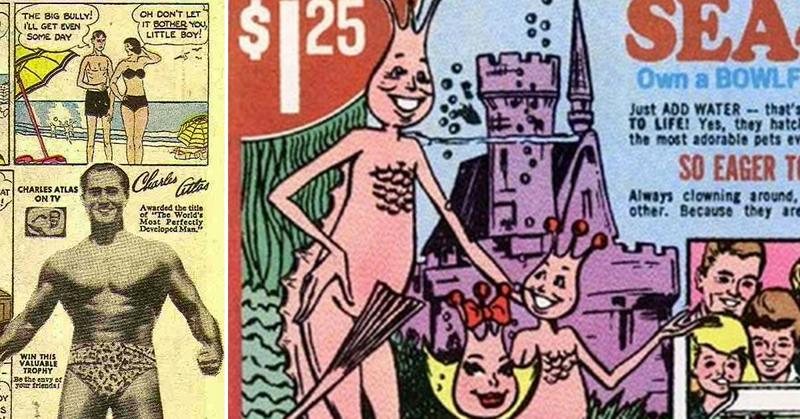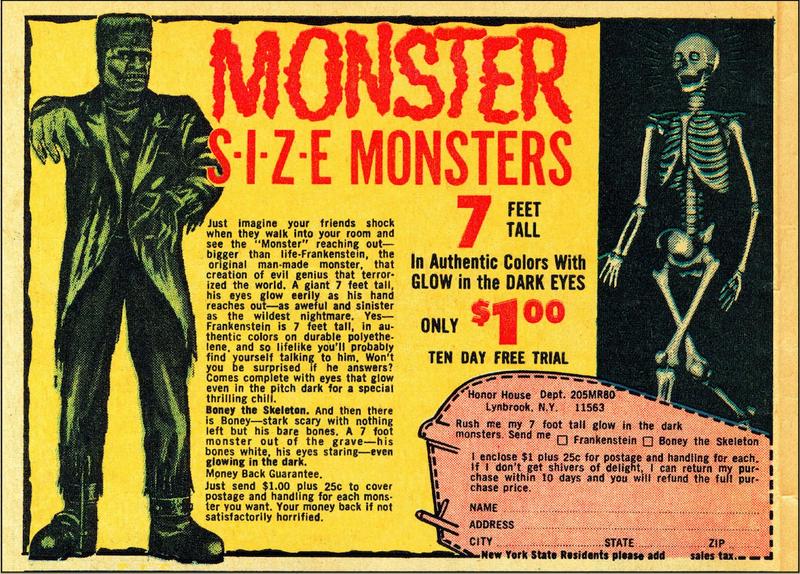Comic Book Rip-Off Ads: Sea Monkeys, X-Ray Specs, And More
By | June 28, 2019

Sea Monkeys were actual humanoids with tails and funny crowned heads that lived in a bowl. A pair of glasses enabled you to see through clothing. And a seven-foot submarine you and a friend could pilot. Advertisements in comic books have promised unbelievable products for decades.
Unbelievable! As in, don't believe it. It's not real.
If you read a comic book between the 1940s and 1980s then you were inundated by cheap-looking ads for everything from toy soldiers to girl-enticing muscles. Anyone who spent their hard-earned lawn-mowing money on any of these products knows that most of the products were definitely not as advertised, but the ads were bizarre enough to make kids keep the faith that the next ad might offer something real.
As strange as many of these ads are, they definitely hold a kind of magic. When you see these ads it’s hard not to feel nostalgic for a time when you could pick up sea monkeys from the pages of a comic.
Attacking The Young Imagination With Advertising Copy

The "giant monster" advertisement was a classic -- and the product was a wall hanging of some sort. Basically a poster. But to youngsters who were prone to believe what they read, the advertising copy was enticing:
Imagine your friends' shock when they walk into your room and see the "MONSTER" reaching out -- bigger than life — Frankenstein, the original man-made monster, that creation of evil genius that terrorized the world. A giant 7 feet tall, his eyes glow eerily as his hand reaches out -- as awful and sinister as the wildest nightmare. Yes -- Frankenstein is 7 feet tall, in authentic colors, on durable polyethylene, and so lifelike you'll probably find yourself talking to him. Won't you be surprised if he answers?
Indeed, that would be surprising.
The First Ads Were Just For Kids

Initial comic book ads weren’t as bizarre as the ones that everyone remembers. They sold things like candy and toys based on the superheroes that were on the front of the comic that readers were holding. You could get a “Superman Ray Gun” or an ant farm for as little as a dollar. This may not seem like a big deal, but in the 1940s these ads were one of the few ways for advertisers to reach out to their base - children.
Without the ability to utilize the medium of television, advertisers had to fill the pages of comics and magazines with ads for toys. Once they bailed on comic books for TV, the ads in the pages of comic books got weird.
Charles Atlas Wanted Comic Readers To Get Shredded

Clearly, advertisers believed that comic book readers were total girlymen. One of the most persistent ads was that of the Charles Atlas work out routine. The ads ran from the 1930s through the ‘80s and even though the look of the ads changed over time they never changed their copy. The ads all told the same story, that of a nerdy wimp getting bullied by a tough guy on a beach.
In the ad, the skinny victim would go home, angry about his shrimpy physique, and pick up the Charles Atlas book. By using the system he would get buff before returning to the beach (or sometimes a park) and whomping the bully who gave him grief.
Ads for X-Ray Glasses Encouraged Junior Peeping Toms

The ad that stoked every young comic book reader’s imagination was the one for X-Ray Specs. These ads offered kids the opportunity to see through everything from fingers, an eggshell, and possibly even clothing all for the cost of a dollar. The fine print in these ads is that they only give the illusion of X-Ray vision and don’t actually allow the wearer to see through anything.
Anyone who sent out for the contraption found that they were actually plastic glasses filled with cardboard that had a depiction of the things you could see if you had x-Ray vision. Sorry kids, this is one product that doesn’t work.
Sea Monkeys Were Just Shrimp Sold By A Nazi Sympathizer

One of the ubiquitous and most intriguing ads that could be found in the pages of a comic book were those for “Sea Monkeys,” an underwater family of weird little mammalian fish that you could keep all to your own. There are a few upsetting truths about Sea Monkeys. First, they were just miniature shrimp with an incredibly short lifespan. Secondly, they were created by Nazi sympathizer Harold Von Braunhut.
Von Braunhut was actually Jewish, but he added “Von” to his last name as a way to make himself seem more Aryan. He didn’t just sell Sea Monkeys, he also marketed X-Ray Specs and a weapon known as the Kiyoga Agent M5, a metal whip that unfurled with spring-action and sold for $59.95. Von Braunhut’s backstory just adds one more strange wrinkle to this inescapable comic book ad.
Readers Could Win A Free Monkey

Anything was possible in the pages of a comic book. Superheroes could leap tall buildings, you were given the power to see through objects with a pair of glasses, and readers could even win a teacup-sized monkey. The ads claimed that if readers sent in their name and address they could win a free monkey. Some readers who claimed that they won said the creature was traumatized by its International travel, while others said that they’d received a corpse through the post. Thankfully, there was actually never a winner.
The Federal Trade Commission actually went after the company behind the free monkey ads and discovered that no prizes had ever been awarded and that they didn’t even have a monkey supplier.
The Polaris Submarine Couldn’t Travel Far. Or Underwater

What kid doesn’t want a submarine? The allure of escaping from home in a legit spy sub that only cost seven dollars was impossible to ignore. Unfortunately, the submarine was hardly the metal submersible that readers expected, and when it arrived it was simply made of cardboard.
The sub required assembly and only came with rubber bands as torpedo and rocket launchers. It required heavy doses of imagination as it actually couldn’t go into the water without disintegrating. Even if you weren't disappointed by the submarine's lack of underwater abilities the next question was where the Polaris was supposed to be stored.
Hundreds Of Plastic Army Men Were Yours For Cheap

Who wouldn’t want to have hundreds of Army men working for the low low price of two dollars? While some readers may have imagined that these plastic figurines would be real deal fighters, most kids knew that these guys were just a good way to build their collections on a small budget. These soldiers were advertised to be made of “unbreakable plastic” and scaled in “full three-dimension.” Often they were shipped in a "footlocker."
These soldiers were in the 1940s created by Milton Levine, a former military man who was aimless following World War II until he found himself in the “exciting world of plastics.” By 1950 the mail-order soldiers were advertised in every comic, and it didn’t take long before they were an unparalleled success. To Lucky Products' credit, the toy that was shipped was actually army men in the quantity advertised. But they were very slender -- flat, actually -- and didn't really look like the army men most kids were expecting. The "footlocker" was about half the size of a kid's lunch box. Lucky Products also sold enticingly large assortments of Roman soldiers, civil war soldiers, and battleships.
